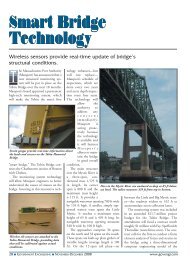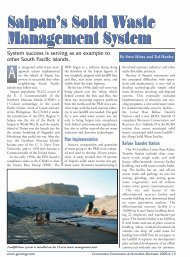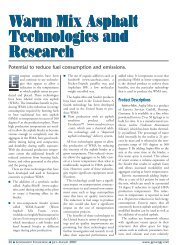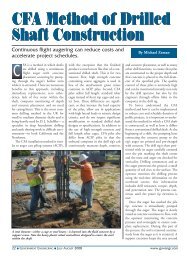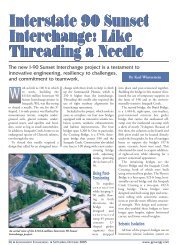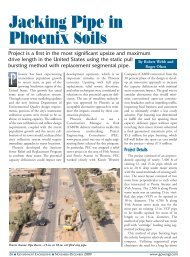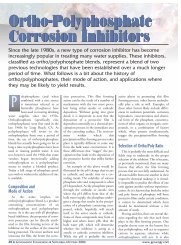Island Community Solves Wastewater Treatment Problems Island ...
Island Community Solves Wastewater Treatment Problems Island ...
Island Community Solves Wastewater Treatment Problems Island ...
Create successful ePaper yourself
Turn your PDF publications into a flip-book with our unique Google optimized e-Paper software.
<strong>Island</strong> <strong>Community</strong><strong>Solves</strong> <strong>Wastewater</strong><strong>Treatment</strong> <strong>Problems</strong>An island community solves its long-termwastewater treatment needs with a new72,000-gpd treatment plant.By Brent Bridges, Tom Hazlett,and Marjorie StrattonAcombination of governmentalsupport, community involvement,innovative engineering,and skilled construction providedthe right mix to solvelong-term wastewater needs in theisland community of Vinalhaven, ME.Its new 72,000-gpd wastewater treatmentfacility and collection system will,according to Maine State Senator SusanCollins, “protect the environment andbring economic opportunity to downtownVinalhaven.”Located in Penobscot Bay and accessibleby ferry from Rockland, Vinalhavenis one of only 14 Maine coastalislands that are inhabited year-round.The project is the fruit of hard work andcommitment by the community, fundingagencies, Maine’s congressional delegation,town officials, and its consultantsand contractors.At the outset of the project six yearsago, many said that building a wastewatertreatment plant would be toocostly, impossible to site, and that constructionwould be too difficult. Theysaid there wasn’t enough soil on theisland to work with, and that the projectwould be too disruptive to everyday lifein the town.These obstacles were real, but manyfactors contributed to the eventual success:community commitment, resolveby the town administration, and stronginterest and support by Maine’s congressionaldelegation and funding agencies.They helped to identify project fundingfrom both traditional and nontraditionalsources, such as a U.S. Department ofAgriculture Rural Development FarmBill.Environmental ChallengesVinalhaven’s location and geologyhave shaped its history and, at the sametime, created challenges in meetingenvironmental regulations. Granitequarries that yielded stone used inbuilding the Brooklyn Bridge andWashington Monument also left behindlarge areas of granite fill unsuited to subsurfacewastewater treatment. With noother treatment in place, raw sewage wasperiodically discharged, soiling the naturalbeauty of Vinalhaven’s harbor andcausing economic and health concerns.In the 1980s, regulatory agenciesbegan pressuring Vinalhaven officials tofind a viable solution. Initial facilitiesand funding plans did not meet theneeds of the community and the townenlisted the services of Woodard & Curran(www.woodardcurran.com) in 1998to develop a facilities plan for wastewatercollection and treatment. The firststep taken was to establish a SewerCommittee from the various stakeholdersin town.The task was to develop a solutionthat would be supported by the community,backed by the Maine Departmentof Environmental Protection(DEP), and budgeted at a cost thatLocated in Penobscot Bay and accessible by ferry from Rockland, Vinalhaven is one ofonly 14 of Maine's coastal islands that are inhabited year-round.30 ■ GOVERNMENT ENGINEERING ■ MAY–JUNE 2005 www.govengr.com
Houston Road CollapseVinalhaven's granite riches yielded stoneused in such projects as the BrooklynBridge and the Washington Monument.funding. Nationwide there’s a significantgap between the need and theresources available for clean water projects.”Vinalhaven was not in a position tosupport a multi-million dollar project,but the Maine DEP was requiringVinalhaven to act. After a great deal ofwork on the part of local officials, withsupport from Maine’s congressional delegation,adequate resources were identified.Congressional leadership was a primaryfactor in obtaining funding,including Maine State RepresentativeTom Allen and especially Senator SusanCollins.Senator Collins and the entire congressionaldelegation worked to findevery potential source of funding for theproject, which included grants from theU.S. Department of Agriculture RuralDevelopment, the Maine DEP, theMaine Department of Economic and<strong>Community</strong> Development, and threeseparate congressionally earmarkedgrants. With the help of these funds, thetown only had to fund 12 percent of theoverall cost, which was $9.8 million.Construction was begun in March 2003and completed in July 2004. GEMr. Bridges, P.E. (bbridges@woodwardcurran.com), is senior vice president, Woodard &Curran, Bangor, ME; Mr. Hazlett is residentengineer, Woodard & Curran, Vinalhaven,ME; and Ms. Stratton is town manager,Vinalhaven, ME.It started off as a typical urban pothole on Alameda Road in Houston, but soongrew big enough to swallow a full-size car, about 60 ft by 40 ft. It closed the roadfor months, disrupted local businesses, and cost about $10 million to repair.With infrastructure coming of age, failures of existing systems and even completecollapse of deteriorated pipe and structures are not hard to find. With over 100miles of large diameter monolithically cast-in-place (MCIP) pipe, Houston is nostranger to this phenomenon.The recent development of a sinkhole led to an intensiveinvestigation of the existing conditions to develop a design that would providea long-term solution to the ongoing problems.The sewer line along Almeda Road was originally installed in a tunnel around1978. Repairs were made in 1991 when 330 ft of HOBAS (www.hobaspipe.com)centrifugally cast, fiberglass-reinforced, polymer mortar (CCFRPM) pipe was used tofix a damaged area. During 1993 and 1994, much of the line was internally or externallygrouted in an effort to extend the life of the line.This was done to seal the lineand combat soil compaction.Even though the line was 40 to 43 ft below the ground surface and 30 ft belowthe groundwater table, evidence of the problem was reaching the surface.The damageto the pavement and surrounding area was proof that the problems were gettingworse.Another indication of an interceptor leak was erratic flow to the AlmedaSims <strong>Wastewater</strong> <strong>Treatment</strong> Plant.On November 5, 2002, a sinkhole appeared and emergency repairs were made.But damage continued to escalate as a nearby water line was broken by the loss ofsupport as the soil strength continued to weaken. Ultimately, the affected area wasso large that two lanes of Almeda Road had to be closed and traffic rerouted.Houston took quick action to assemble and coordinate a team to repair the AlmedaRoad cave in.The city chose Pate Engineers (www.pateeng.com) as consulting civilengineer. Tolunay-Wong (www.tweinc.com) as geotechnical consultant, BRH Garver(www.brhgarver.com) as contractor, and HOBAS as the pipe supplier. They werebrought together to find a solution. J. E. Pate, Jr., principal at Pate Engineers, explainedthat years of groundwater infiltration had carried fine soils through small cracks in the84-in. MCIP pipe and this weakened and compromised the native soil to the point offailure. As the embedment worsened, additional cracks developed, causing more infiltrationand continuing the vicious cycle.The area adjacent to the collapse was stabilized, dewatered, and a liner plate shaftwas constructed. Next, the flow was rerouted using 3,000-gpm bypass pumps.To assessthe extent of the problem, the 28,000 ft of existing interceptor was evaluated andinspected by closed circuit TV.Areas that were in need of sliplining were subsequentlycleaned in preparation for rehabilitation.The sliplining pipe, which was 72-in. in diameterwith a pipe stiffness of 46 psi, was used in several locations adjacent to the sinkholeand the liner plate shaft.The sliplined section included lengths of 1,700 ft, 360 ft, and370 ft in the problem areas.Ground penetrating radar was used to determine where the soil strength wascompromised and future settlement might be expected. Soil grouting and underpinningwere required in this area to give the embedment adequate strength to supportthe pipe. In the location of the sinkhole itself, HOBAS 72 stiffness FWC couplingpipes were also installed by direct bury.The total repairs included one-half mileof CCFRPM pipe.The consulting engineer had the opportunity to inspect the 1991 installation andfound no evidence of leaks. The new pipe installation was also inspected withremote TV cameras, again revealing no evidence of leakage. In less than a year afterthe first sinkhole appeared, the team was assembled, the situation evaluated,designed, repaired, and all four lanes of Almeda Road were back in service. GE32 ■ GOVERNMENT ENGINEERING ■ MAY–JUNE 2005 www.govengr.com



